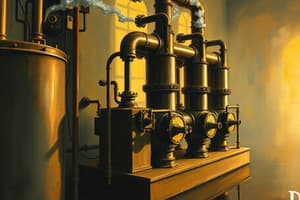Podcast
Questions and Answers
What is the purpose of purging recycled ethylene to the Purge Gas Header?
What is the purpose of purging recycled ethylene to the Purge Gas Header?
To limit ethane concentration in the ethylene feed to the reactors.
How is the C4 (butene) fraction separated from the remaining ethylene?
How is the C4 (butene) fraction separated from the remaining ethylene?
By separating it from the butene product stream after recycling.
What is the function of E-373 in the ethylene recycling process?
What is the function of E-373 in the ethylene recycling process?
It acts as a Purge Gas Heater that cools the overhead vapor from D-330.
What role does the D-380 (Debutenizer Reflux Drum) play?
What role does the D-380 (Debutenizer Reflux Drum) play?
Where does the overhead vapor from the top of T-370 get routed?
Where does the overhead vapor from the top of T-370 get routed?
What is returned to T-370 as reflux from D-370?
What is returned to T-370 as reflux from D-370?
What happens to the vapor from D-375 (Recycle Cylinder Suction Drum)?
What happens to the vapor from D-375 (Recycle Cylinder Suction Drum)?
How is the bottom of T-370 treated?
How is the bottom of T-370 treated?
What is the purpose of the propylene refrigerant in the E-370 condenser?
What is the purpose of the propylene refrigerant in the E-370 condenser?
Why is it important to dry the stream in D-362A/B before routing to F-362?
Why is it important to dry the stream in D-362A/B before routing to F-362?
Flashcards are hidden until you start studying
Study Notes
Ethylene Recycling Process
- Recycled ethylene is purified by removing C4 components (butene) to limit ethane concentration in the ethylene feed.
- Purged recycled ethylene is directed to the Purge Gas Header to maintain appropriate concentration levels.
Separation and Cooling
- The C4 fraction and remaining ethylene are separated from the butene product stream.
- Overhead vapor from the high-pressure recycle knockout drum (D-330) is sent to the tube side of the purge gas heater (E-373) for cooling.
Deethenization Process
- The cooled vapor enters the deethenizer (T-370) at tray 18 after being passed through the reflux drum (D-370).
- A recycled stream from the debutenizer reflux drum (D-380) is processed through booster/recycle compressors (C-360A/B).
Drying and Filtration
- The recycled stream is dried in the deethenizer feed dryers (D-362A/B) before moving to the deethenizer feed filter (F-362) and arriving at tray 13 of the deethenizer.
Condensation and Reflux
- Overhead vapor from the deethenizer is directed to the deethenizer condenser (E-370), partially condensed with propylene refrigerant.
- Condensed vapor is routed to the deethenizer reflux drum (D-370), where liquid is returned to the deethenizer as reflux using reflux pumps (P-370A/B).
Vapor Route Management
- Most vapor from the reflux drum (D-370) goes to the recycle cylinder suction drum (D-375); some vapor is sent to the purge gas heater (E-373).
- Liquid from the recycle cylinder suction drum is routed to the water wash vapor scrubber (T-350).
Recycle and Heating
- Overhead vapor from the recycle cylinder suction drum enters the booster/recycle compressors (C-360A/B) for compression.
- This vapor is mixed with vapor from the deethenizer, routed to the condenser (E-370), while deethenizer bottoms are sent to the deethenizer reboiler (E-375) for heating with 100 psig steam.
Finalization
- Overhead vapors are returned to the deethenizer below tray 1 for further processing.
- Liquid bottoms exiting the deethenizer reboiler are directed to the debutenizer (T-380).
Studying That Suits You
Use AI to generate personalized quizzes and flashcards to suit your learning preferences.



